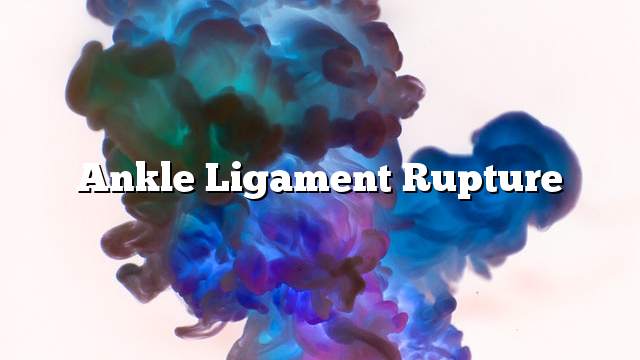ankle
Ankle is one of the large joints of the body, consisting of the confluence of the tibia, the fibula and the talus, and the crevices from the ankle region are the protrusion in the region The inner of the ankle is called the medial malleolus, and the posterior appearance is called the posterior malleolus. The protrusion in the outer part of the heel is called the lateral malleolus. Ligaments are found in the joint The coast to link these bones together and foot, as is detailed in the function of the ankle to allow foot movement up and down, and the two sides.
Ankle ligaments
In the ankle there are many ligaments that provide strength and support to the joint. The basic ligaments on the medial side of the foot are known as the Deltoid Ligament and the calcaneonavicular ligament. The ligaments on the lateral side are the cleft palate ligament Anterior talofibular ligament, posterior talofibular ligament, lateral talocalcaneal ligament, calcaneal fibular ligament, and ventricular ligament English: Syndesmosis).
Torn ankle ligaments
When the ankle is sprained as a result of a sudden movement of the ankle that exceeds the normal degree of movement within its ankle, a full tear, tear or cut of one or more joints can occur. Ankle sprains are classified according to the severity of the injury and rupture The aggregate of the joint ligaments is three degrees.
First degree torsion
The first-degree ankle sprain causes ankle ligament rupture and is a minor tear. The symptoms include slight pain, swelling of the joint, and difficulty walking, but does not impede the function of the joint. The patient needs four to six weeks to recover from this. Sprains.
Second degree torsion
The patient may suffer from some of the symptoms, including swelling of the ankle, feeling of pain when pressed, and difficulty walking on the infected foot, and show the bruise of the place of torsion, and needs a patient recovery period ranging Between four and eight weeks.
Third degree torsion
As a result of torsion the third degree of severe swelling of the ankle joint, in addition to the feeling of severe pain when touching the area of torsion, and inability to walk on the infected foot, and instability of the joint in place, and may extend the healing period of the joint up to twelve weeks, may need to undergo surgery To treat damage to the joint.
Diagnosis of ankle sprain
The doctor performs the clinical examination of the ankle to identify the damaged ligaments, and also moves the ankle in several directions to determine the range of movement, and then ask for X-ray image known as X-ray image to be sure that there is no break, Severe injury to the ligaments or injury to the outer surface of the ankle. The doctor requires a magnetic resonance imaging image.
Treatment of ankle sprain
The importance of the treatment of ankle sprain in the avoidance of any complications of the foot, such as chronic pain or instability and stability of the joint in place, and can treat torsion depending on the degree.
Treatment of first degree torsion
To treat first degree torsion, it is recommended to follow these steps:
- Avoid walking, carrying heavy objects, resting the infected foot, or using crutches for walking.
- Put some pieces of ice in a cloth and apply them to the affected ankle, and for no more than twenty minutes to relieve bulging.
- Pressing the injury site to relieve swelling and provide some stability to the joint while healing the ligaments affected.
- Lie down and lift the injured leg.
Second degree torsion treatment
The second degree of torsion can be performed by the doctor, and the first step can be followed. The second degree of torsion healing takes longer than the first degree of torsion healing.
Third degree torsion treatment
A third-degree torsion may be used for two to three weeks. Some patients, especially those with ankle spasms, may need to repair the damage to the ankle joint and tighten the ligaments surgically,
It is worth noting that people who have a third degree torsion are at risk of permanent ankle instability.
Rehabilitation of the joint
It is important to rehabilitate the joint after the injury until it is fully restored and to reduce the chance of injury again. The rehabilitation program helps to avoid chronic pain and ankle instability and reduces the possibility of arthritis, so it is important to complete the program completely. , The first stage includes joint rest, relieve swelling and allow time for healing to be done. In the second stage, the patient is taught some exercises aimed at increasing the elasticity of the injured joint, strengthening ligaments and muscles, and helping to restore balance. The third stage of the rehabilitation of the ankle can start doing the usual activities including walking, jogging and start to carry relatively light weights, then it can do exercise other sports like tennis, football, basketball.
